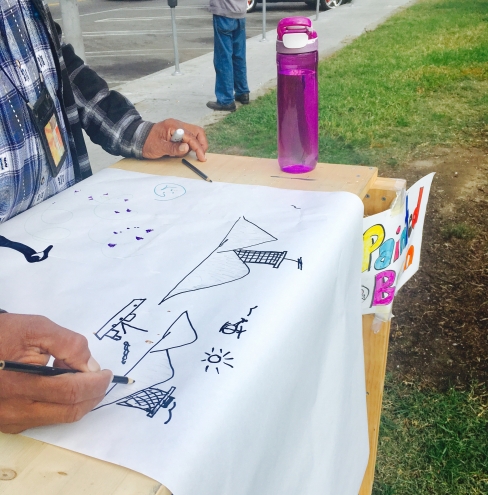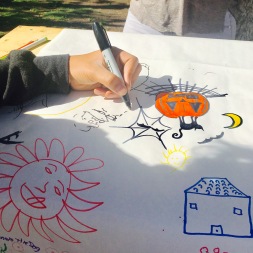
Over the past few weeks I have had an opportunity to lead Painted Brain groups, in various locations around Los Angeles, for adults who will benefit from increased opportunities to socialize and engage in meaningful activities that elicit creative artistic expression. While this component of my position at Painted Brain is not considered ‘occupational therapy’ due to the service not being billed as such, I still approach this work through the lens of an occupational therapist. Thus, I continuously keep at the forefront of my mind the knowledge that adults labeled with mental illness “have been characterized as being at high risk for limited participation in meaningful activities, having few opportunities for emotional fulfillment and personal growth, and experiencing social marginalization” (Edgelow & Krupa, 2011, p.267). My mind also persistently appreciates the knowledge that “human beings define their lives, cultures, values, and worth through activities” (Breines, 1995, p. 3) and that “it is the interactions of everyday life, rather than particular interventions in mental health settings that are the primary medium through which recovery occurs” (Sutton et al., 2012, p. 142).
In approaching the task of developing an occupational therapy service at Painted Brain, I have been studying the characteristics of being labeled with mental illness, and I have been developing an understanding of how these characteristics lead to lack of participation in meaningful activity and social isolation. Historically, boundaries have persisted that exclude adults who are labeled with mental illness and prevent participation in the everyday activities that lead to community integration, important social roles, and meaningful contribution to self and others; “a well-known example of exclusion for this group has been an historic deprivation from developing their true selves and potential because of being isolated in hospitals or cloistered in homes without something meaningful to do or be…” (Townsend, 2012, p.9). This physical separation from the greater community is exaggerated by lack of opportunity for meaningful doing, holistically being, or potentially becoming anything more than a person labeled with mental illness. Even when adults who are labeled with mental illness discover a means to reside physically within their communities, “community living for some and the deinstitutionalization of supports for others in North America leaves a vulnerable, impoverished group of adults as alienated and marginalized through poverty, drug addiction, stigmatization, abuse from others, isolation from friendships, and persistent, disturbing, disruptive mental symptoms” (Townsend, 2012, p.9). This causes individuals to fall into a cycle of disengagement from meaningful activity, increased time spent in sleep and passive leisure, and decreased productivity, which altogether lead to decreased social interactions, decreased physical activity, and limited community involvement (Krupa et al., 2010).
 A more important realization, however, is that this disengagement and marginalization does not only negatively affect the population of adults who are labeled with mental illness, but universally concerns the health of all of us, because social exclusion is “created by structural determinants and large scale organizational practices, not individual circumstances” (Townsend, 2012, p.14). Therefore, social and occupational justice will advance when we as a civil society “organize universal rights to affiliations that include humans, other species, and control over one’s environment…without occupational marginalization or occupational deprivation” (Townsend, 2012, p.15).
A more important realization, however, is that this disengagement and marginalization does not only negatively affect the population of adults who are labeled with mental illness, but universally concerns the health of all of us, because social exclusion is “created by structural determinants and large scale organizational practices, not individual circumstances” (Townsend, 2012, p.14). Therefore, social and occupational justice will advance when we as a civil society “organize universal rights to affiliations that include humans, other species, and control over one’s environment…without occupational marginalization or occupational deprivation” (Townsend, 2012, p.15).
What unique contribution then, can I as an occupational therapist make, in addressing the occupational and social needs of adults who are labeled with mental illness? One step is to develop a community-based service that not only provides opportunity for engagement in meaningful activities, but that also facilitates realization and understanding of the benefits to overall health and wellbeing that balanced participation will provide. A step further will be to exchange knowledge and evidence with other mental health providers, organizations, and the general population regarding the significance of engagement in meaningful activities to overall health; the right of all individuals to experience dignity, health, safety, and social inclusion; and the connection between meaningful engagement and social justice.
The occupational therapy service at Painted Brain will take on a range of forms, including having a presence in Painted Brain’s community center, and by offering a group service that facilitates participation in a variety of and balance between activities of productivity, leisure, sleep, and self-care. Sutton et al. (2012) suggest that the “task of enabling occupation involves creating space for the ‘play’ of doing, that is, to open the interplay of being and world” (p.148). The Painted Brain community center truly enables this “play of doing” by offering a space where people can freely engage in a variety of activities, make meaning through participation in creative expression, and that supports involvement in everyday life, which as Sutton et al. (2012) advise, should be a “central focus of occupational therapy practice” (p.148). 
The group occupational therapy service is designed to facilitate reflection on current levels of activity, re-imagination of the self to set goals for activity participation, and reintegration into the greater community, such that individuals may break out of their cycles of inertia and resume movement toward realizing their full potential. The focus on the degree to which a person develops balanced patterns of activity and rest, a variety and range of meaningful activities and routines, and the ability to move around in the community and interact socially will be complemented by a group format that encourages active participation, promotes social support, and enhances opportunity for sharing of ideas and experiences (Krupa et al., 2010). Despite evidence that health professionals often have difficulty engaging the general population in behavior change and health-promoting activities, research on an activity-health intervention implemented by occupational therapists with a group of adults with serious mental illness found that this approach is effective in influencing occupational balance by resulting in increased time spent in general activity and decreased time spent in sleep (Edgelow & Krupa, 2011). At Painted Brain, occupational therapy services will soon be implemented, for adults who are labeled with mental illness, to provide increased opportunities to socialize and engage in meaningful activities that elicit creative expression, promote social inclusion and full community participation, and facilitate resumed movement toward realizing one’s full potential.
Sharon Vincuilla, OTR, CPDT-KA
Occupational Therapy Doctoral Resident
References
Breines, E. B. (2004). Occupational therapy: Activities for practice and teaching. London: Whurr.
